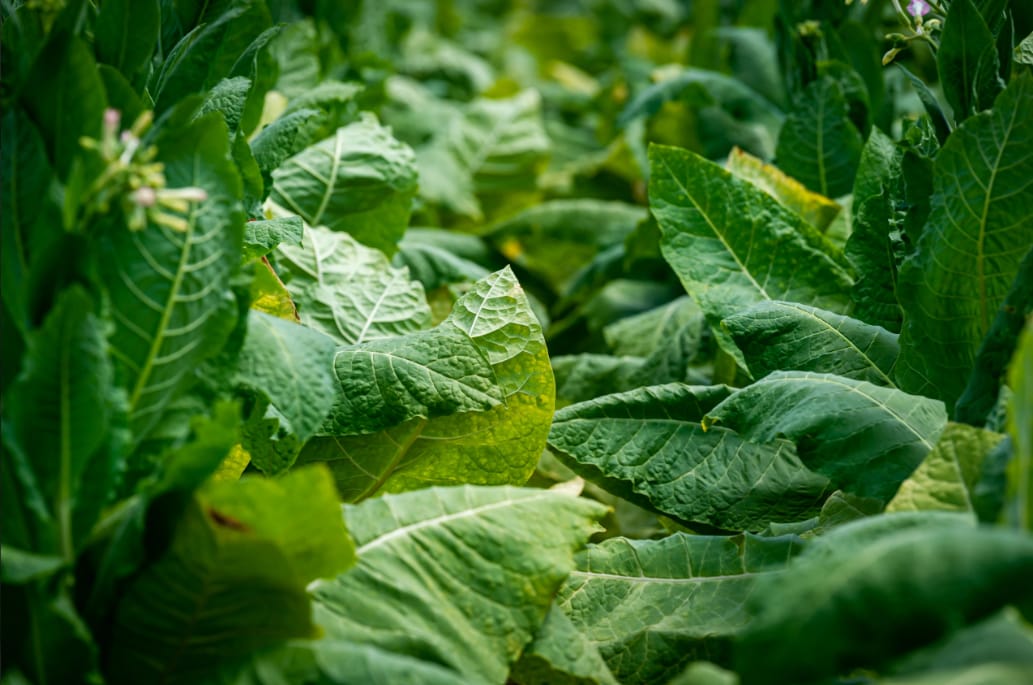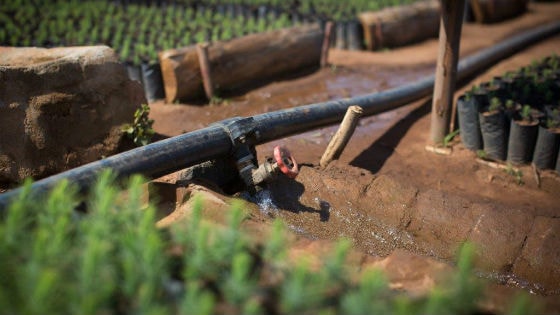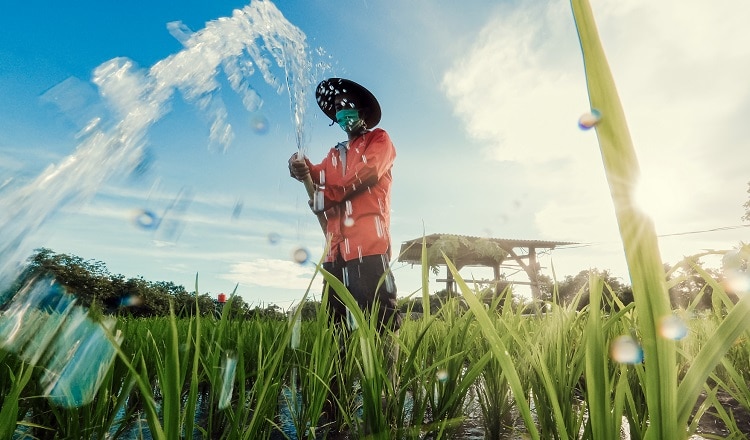Tobacco Curing in China
As a company with a sizeable agricultural supply chain, PMI recognizes the importance of mitigating environmental impact while maintaining productivity. China is one of our key markets for tobacco leaf sourcing and has been an important focus area for driving decarbonization by substituting fossil fuels for curing with renewable sources for many years.
In 2023, China produced around 1.94 million metric tons of tobacco, making it the world's largest tobacco producer.1 The Yunnan province is often referred to as the heartland of tobacco cultivation, covering the largest tobacco-growing region in the country that plays a pivotal role in supporting the livelihoods of local farmers. As such, Yunnan represents a vast opportunity for sustainable innovation around tobacco.
The curing process for flue-cured tobacco is one of the most energy-intensive stages of tobacco production, often accounting for a significant portion of its agricultural carbon footprint2 depending on the source of fuel. To reduce GHG emissions in tobacco curing, PMI began working with its supply chain partners more than a decade ago to implement innovative methods to optimize curing and promote decarbonization by transitioning away from fossil fuels.
Focused efforts to support accelerated transition
PMI’s Sustainable Curing Fuel Program is global but intensifies its efforts in geographies where the transition to lower carbon alternatives is more difficult because of, for example: alternative curing feedstocks availability, market and technological gaps as well as the need for improved farmers’ capabilities in employing non-fossil sources. In China, success in decarbonizing the curing process came from converting fossil fuels used in curing to biomass pellets composed of wood-waste and agrowaste.
In 2023, we successfully phased out coal in our tobacco supply chain. By our calculations, 92,550 metric tons of CO2-equivalent emissions were avoided in 2023. With the same approach to calculate benefits, over the next decade (2023-2033), this phase out is projected to prevent more than 1.02 million metric tons of CO2 emissions compared to baseline conditions.
These efforts were supported by the application of an internally designed but externally verified MVR (Monitoring Verification and Reporting framework). The MVR Framework is key for measuring progress on decarbonization towards net-zero. As the sustainable curing program looks to include other sources of fuel – such as the expansion to electricity, the MVR must also encompass technology and production model changes.
PMI’s MVR Framework for Sustainable Curing Fuels
PMI’s MVR Framework for Sustainable Curing Fuels, developed in 2016, provides a structured approach to tackling deforestation risks and GHG emissions, improving fuel traceability, and ensuring that tobacco curing practices align with our sustainability goals. By establishing clear principles, MVR enables tobacco suppliers and farmers to transition toward cleaner energy sources in a measurable and accountable manner.
PMI Leaf Curing Fuel Monitoring Framework
| 1. Know Your Fuel |
| 1.1. Total amount of purchased cured tobacco (Kg) 1.2. Total fuel for curing tobacco purchased by fuel source (kg or m3) 1.3. Number of curing barns used per barn type | Tobacco survey Barn survey Fuel-usage survey/Farmer survey |
| 2. Be Sustainable | Indicate percentage of verified sustainable fuel types Zero gross deforestation Zero net deforestation No coal usage Proof of self sufficiency | 2.1. Amount of purchased tobacco cured with sustainable and unsustainable source of fuels supported by documentation 2.2. Number of initiatives to reach self-sufficiency and quantity of firewood that is self-sufficient 2.3. Curing fuel is fully traceable to the source supported by documentation 2.4. Forest risk maps developed for countries using firewood 2.5. Forest risk mitigation plan design and implemented by risk categories | Report sustainability of wood fuels Report sustainability of agrofuels Forest risk mitigation plan for Primary and Protected Forest |
| 3. Be transparent and replicable | Clear reporting Knowledge sharing Standardize processes Quality assurance Documentation | 3.1 SOP developed for data reported in the monitoring framework | Standard Operating Procedure Quality check process Provision of documentation |
| 4. Involved Stakeholders | Understand Stakeholders and local context Engage Stakeholders in the process Stakeholders' capacity building Improve awareness Communicating | 4.1 Stakeholder engagement plan implemented 4.2 Capacity building activities provided to Stakeholders 4.3 Communication strategy implemented | Understand local context Stakeholder engagement plan Capacity building activities Communication strategy |
Implementing the MVR Framework For Sustainable Curing Fuels to Curing Barns in China
In 2024, through continued development of its Sustainable Curing Fuel program, PMI tested the MVR Framework to monitor the performance of existing electric curing barns in China, which reached 17,000 operational units at the end of 2024. This is meaningful because it’s the first time the MVR framework had been applied to electric curing– enabling these advancements in new technologies and approaches for decarbonization to be methodically measured. This opens the possibility to include them in our sourcing strategy.
Implementation of the MVR indicators for curing barns in China allowed for:
- Improved sustainability tracking: Monitoring alternative energy sources used for curing, such as biomass pellets and electricity, as well as their associated emission factors.
- Transparency and verification: Ensuring that the progress toward sustainability targets through use of these alternative fuels is measurable and externally validated.
A multi-stakeholder approach
Applying the MVR framework to electric curing barns has revealed meaningful results. This work is at the basis of the adoption of new technologies creating a market for them and ensuring alignment with sustainability standards in the creation of electricity powered curing centers – in line with China’s objectives to achieve decarbonization targets during this decade.
This multi-stakeholder approach has been essential for scaling solutions that reduce emissions versus fossil fuel while maintaining the economic viability of tobacco farming communities. By working together with our industry partners, advancements in sustainable curing practices are both practical and beneficial for all parties involved.
The future of MVR in sustainable agriculture
As sustainability challenges evolve, so must our ability to monitor and measure progress. PMI’s application of MVR to electric curing barns in China represents an important step in improving transparency, reducing environmental impact, and driving accountability across the supply chain. MVR was at the basis our successful efforts to phase out coal, reduce emissions, and promote sustainable energy alternatives in tobacco curing. Now, with its application to electric curing barns, using the MVR’s robust framework for data collection, verification, and continuous improvement gives us the visibility needed to consider electric curing in our sourcing decisions.
We are also setting an example for other businesses looking to minimize their environmental footprint. As we scale these efforts, knowledge-sharing with other agricultural sectors becomes increasingly important. The application of our MVR principles in other crop supply chains could provide similar benefits, helping industries transition toward low-carbon, resource-efficient production models.
Looking ahead, we aim to continue refining and expanding our MVR framework, integrating new technologies and methodologies to enhance sustainability tracking.



